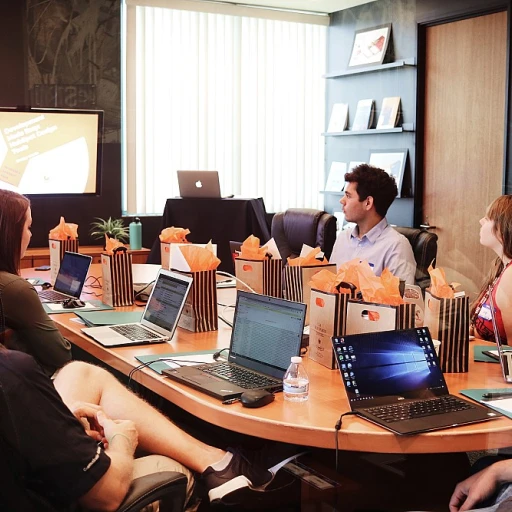Understanding the Role of One-on-One Meetings in Succession Planning
{"The Crucial Role of Personalized Discussions in Succession Planning
\n\nIn the domain of succession planning, one-on-one meetings serve as instrumental tools to effectively guide future leaders within an organization. These meetings hold great potential to bridge communication gaps between managers and their direct reports, ensuring that the goals aligned with development are continually being met. Such personalized discussions provide a unique opportunity for open dialogue, helping to lay down a foundation for sustainable growth.\n\nA well-structured meeting agenda is imperative. The agenda will typically cover various aspects such as employees’ current performance, immediate challenges, and long-term goals. Regular check-ins help both managers and employees stay aligned regarding the progression of these topics. Frequent engagement fosters a transparent atmosphere where feedback can be exchanged candidly, allowing employees to take actionable insights away from each session.\n\nMoreover, adopting a structured meeting template ensures consistency across the board. Templates in Word, Google Docs, or downloadable samples are invaluable in maintaining this consistency. They help track and record action items, discussion points, and future meeting plans, contributing to coherent staff meetings. These templates serve as vital records that managers can revert to for ongoing development insights and ensuring that every team member's progress is systematically documented.\n\nTo further explore the significance of personalized discussions in effective succession planning, and the vital role such strategies play in preboarding and onboarding, check out this comprehensive guide on preboarding and onboarding strategies.\n\nThrough the adaptable use of meeting templates, organizations can build a robust succession plan that prioritizes open communication and continual development. Subsequent sections will delve into crafting adaptable templates for different leadership levels and how feedback mechanisms can be incorporated to further enhance these one-on-one meetings."}Key Elements of a Successful One-on-One Meeting Template
Essential Components for Effective One-on-One Meeting Templates
For any organization aiming to enhance its succession planning process, crafting a detailed and thoughtful meeting template is crucial. A successful one-on-one meeting template should aim to foster open communication, development, and progress tracking. Below are some key elements that can be incorporated:
- Structured Meeting Agenda: Begin with a clear agenda to guide the meeting. It ensures that every aspect, from discussing goals to reviewing past action items, gets covered. Utilizing agenda templates in Google Docs can help in creating a standardized approach across team members.
- Open-Ended Questions: These facilitate a meaningful dialogue between managers and employees, encouraging open communication. Questions should be designed to elicit thoughtful responses about the employee's ambitions, challenges, and feedback on development opportunities.
- Goal Alignment and Review: Discussion around specific, actionable goals helps direct reports align with organizational objectives. This should be a standing item on the meeting agenda to ensure consistent progress checkpoints.
- Feedback Mechanisms: Integrate methods for providing and receiving feedback within the template. This process should include both employee feedback and management insights. Regular feedback loops can improve employee engagement and satisfaction.
- Progress Tracking: Maintain a section for monitoring the goals and development milestones set in previous meetings. This allows for transparent check-ins on progress and helps managers adjust the employee's development plan as necessary.
- Action Items and Follow-Up: Each meeting should conclude with clearly defined action items. Ensure these are revisited in subsequent meetings. Having a 'check' system in place on these items will help track who is responsible and the expected completion timeline.
By integrating these components into your meeting templates, organizations can ensure that one meetings are productive, fostering a strong foundation for effective succession planning. A free agenda or word template download can be advantageous for customizing these templates to fit unique organizational needs.
Customizing the Template for Different Leadership Levels
Tailoring the Template for Various Hierarchical Tiers
Crafting a versatile one-on-one meeting template requires adapting its structure to accommodate different levels of leadership within an organization. Here are some strategies for customizing the meeting agenda to ensure it meets the needs of various hierarchical tiers:- Adjust the Meeting Focus: For senior managers meeting with their direct reports, the focus might be on strategic discussions, development goals, and broader organizational objectives. Meanwhile, one-on-one meetings between team leaders and their team members might concentrate more on individual performance, immediate goals, and actionable feedback.
- Set Appropriate Questions and Action Items: Customize the questions and action items to align with each management level. For instance, senior-level one meetings might include questions about high-level strategies and long-term goals, while meetings at the team member level could focus on detailed project check-ins and immediate concerns.
- Use Relevant Meeting Templates: Utilizing different templates like a google docs template or a word template can provide flexibility in tailoring meetings. Managers might prefer digital templates that allow for easy tracking and sharing, while others might benefit from printable agendas to facilitate note-taking during confidential discussions.
- Encourage Open Communication: Ensure the meeting templates foster an open atmosphere where employees at all levels feel comfortable providing feedback and discussing their development needs. This approach is crucial for creating a supportive environment and promoting transparent communication.
Incorporating Feedback Mechanisms into the Template
{ "result": "Seamlessly Integrating Feedback for Continuous Improvement
\n\nFeedback plays a crucial role in succession planning, and understanding how to incorporate it effectively into your one-on-one meeting template can significantly enhance the process. Feedback mechanisms ensure that employees’ perspectives are heard, affirming that their professional growth is aligned with organizational goals.\n\nCreating an Open Environment for Feedback\n\nThe foundation for integrating feedback starts by fostering an open meeting environment. This entails crafting a one meeting agenda that encourages employees to speak candidly with their managers. Such openness contributes to identifying actionable points for improvement and development. Regular check-ins can serve as conduits, promoting open dialogue that is essential for robust succession planning.\n\n- \n
- Encourage employees to prepare and ask specific questions during meetings. \n
- Schedule time in the meeting agenda templates to discuss both positive feedback and areas needing improvement. \n
- Use digital tools like Google Docs or specific agenda will templates to track feedback over time for each direct report. \n
Using the Template to Track Progress and Development
Tracking Progress and Continuous Development
An essential aspect of succession planning is the ability to monitor progress and foster continuous development. Using a well-defined meeting template is crucial in this process, as it outlines the agenda and ensures that key points are addressed.
A structured meeting agenda allows managers to have meaningful conversations with their direct reports, ensuring that every meeting brings value to both parties. These one-on-one conversations help identify action items and set clear goals, aligning them with the employee's development path and the organization’s succession plan.
By incorporating regular check-ins, the team can engage in open discussion, where feedback is provided and received constructively. These meetings should encourage questions and dialogue, offering a platform for employees to express their career aspirations and discuss challenges. This ongoing interaction ensures that both managers and employees remain aligned and committed to developmental goals.
The use of digital tools such as Google Docs or downloadable templates can enhance the accessibility and consistency of these one meetings. Managers can quickly check progress and evaluate changes using these tools, providing an up-to-date view template for retrospection and planning.
Moreover, development tracking through meeting templates allows managers to address and realign goals as necessary, fostering a dynamic approach to succession planning. These systematic trackings of meetings reveal patterns and areas for improvement within the organization, leveraging feedback to fine-tune strategies and ensure the effectiveness of leadership development initiatives.
Overcoming Challenges in Implementing the Template
Navigating Obstacles in Implementation
Implementing an effective one-on-one meeting template can come with its share of challenges. However, addressing these obstacles is crucial if you want to reap the benefits of a structured approach to succession planning. Here's how you can tackle some common issues:- Resistance to Change: Many managers or team members might resist adopting new meeting templates or standardized agendas. Educate your staff on the purpose of these templates and how they can streamline your succession planning efforts. A clear communication strategy can decrease resistance and enhance acceptance.
- Lack of Engagement: Encouraging full participation in one on one meetings can be tricky. Craft meetings to be open and interactive, with an agenda that allows employees to voice their questions and concerns. This can help in securing buy-in from your direct reports and increase engagement.
- Consistency in Application: Often, consistency is a challenge in using meeting templates across different managerial levels. Customize templates for each leadership level to ensure they are relevant and practical. Preparing a free agenda or using template google docs or a word template can help maintain uniformity.
- Feedback and Development: Incorporate feedback mechanisms within the template to enable managers to refine their approaches. Continuous feedback ensures that the meeting agenda remains aligned with the employees' developmental goals and company objectives.
- Tracking Progress: The template should serve as both a tool for communication and a method for tracking progress. Ensure it includes sections to document action items and employees' developmental milestones. This will aid in setting clear goals and monitoring outcomes consistently.



